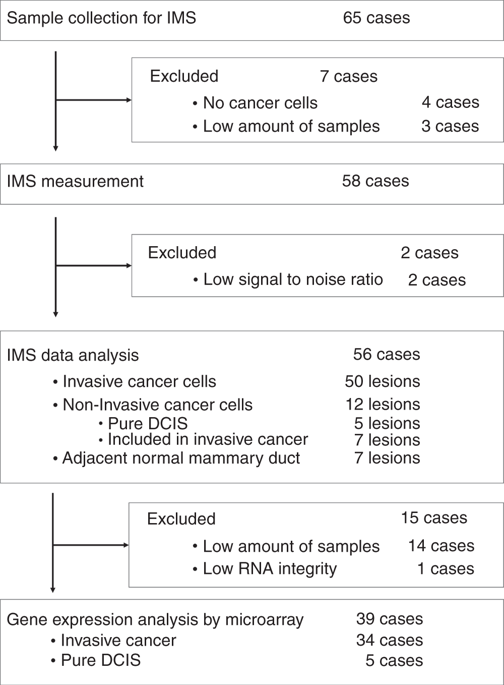当前位置:
X-MOL 学术
›
Br. J. Cancer
›
论文详情
Our official English website, www.x-mol.net, welcomes your
feedback! (Note: you will need to create a separate account there.)
High-resolution imaging mass spectrometry combined with transcriptomic analysis identified a link between fatty acid composition of phosphatidylinositols and the immune checkpoint pathway at the primary tumour site of breast cancer.
British Journal of Cancer ( IF 6.4 ) Pub Date : 2019-12-10 , DOI: 10.1038/s41416-019-0662-8 Masahiro Kawashima 1, 2 , Mariko Tokiwa 1 , Tomomi Nishimura 1 , Yukiko Kawata 1 , Masahiro Sugimoto 3 , Tatsuki R Kataoka 4 , Takaki Sakurai 4 , Keiko Iwaisako 5 , Eiji Suzuki 1 , Masatoshi Hagiwara 6, 7 , Adrian L Harris 2 , Masakazu Toi 1
British Journal of Cancer ( IF 6.4 ) Pub Date : 2019-12-10 , DOI: 10.1038/s41416-019-0662-8 Masahiro Kawashima 1, 2 , Mariko Tokiwa 1 , Tomomi Nishimura 1 , Yukiko Kawata 1 , Masahiro Sugimoto 3 , Tatsuki R Kataoka 4 , Takaki Sakurai 4 , Keiko Iwaisako 5 , Eiji Suzuki 1 , Masatoshi Hagiwara 6, 7 , Adrian L Harris 2 , Masakazu Toi 1
Affiliation

|
BACKGROUND
The fatty acid (FA) composition of phosphatidylinositols (PIs) is tightly regulated in mammalian tissue since its disruption impairs normal cellular functions. We previously found its significant alteration in breast cancer by using matrix-assisted laser desorption and ionisation imaging mass spectrometry (MALDI-IMS).
METHODS
We visualised the histological distribution of PIs containing different FAs in 65 primary breast cancer tissues using MALDI-IMS and investigated its association with clinicopathological features and gene expression profiles.
RESULTS
Normal ductal cells (n = 7) predominantly accumulated a PI containing polyunsaturated FA (PI-PUFA), PI(18:0/20:4). PI(18:0/20:4) was replaced by PIs containing monounsaturated FA (PIs-MUFA) in all non-invasive cancer cells (n = 12). While 54% of invasive cancer cells (n = 27) also accumulated PIs-MUFA, 46% of invasive cancer cells (n = 23) accumulated the PIs-PUFA, PI(18:0/20:3) and PI(18:0/20:4). The accumulation of PI(18:0/20:3) was associated with higher incidence of lymph node metastasis and activation of the PD-1-related immune checkpoint pathway. Fatty acid-binding protein 7 was identified as a putative molecule controlling PI composition.
CONCLUSIONS
MALDI-IMS identified PI composition associated with invasion and nodal metastasis of breast cancer. The accumulation of PI(18:0/20:3) could affect the PD-1-related immune checkpoint pathway, although its precise mechanism should be further validated.
中文翻译:

高分辨率成像质谱结合转录组分析确定了磷脂酰肌醇的脂肪酸组成与乳腺癌原发肿瘤部位的免疫检查点通路之间的联系。
背景技术磷脂酰肌醇(PI)的脂肪酸(FA)组成在哺乳动物组织中受到严格调节,因为其破坏会损害正常细胞功能。我们之前通过使用基质辅助激光解吸和电离成像质谱(MALDI-IMS)发现其在乳腺癌中的显着改变。方法我们使用 MALDI-IMS 可视化 65 个原发性乳腺癌组织中含有不同 FA 的 PI 的组织学分布,并研究其与临床病理特征和基因表达谱的关联。结果 正常导管细胞 (n = 7) 主要积累含有多不饱和 FA (PI-PUFA)、PI(18:0/20:4) 的 PI。在所有非侵袭性癌细胞中,PI(18:0/20:4) 被含有单不饱和 FA (PIs-MUFA) 的 PI 取代 (n = 12)。 54% 的侵袭性癌细胞 (n = 27) 也积累了 PIs-MUFA,而 46% 的侵袭性癌细胞 (n = 23) 则积累了 PIs-PUFA、PI(18:0/20:3) 和 PI(18: 0/20:4)。 PI(18:0/20:3)的积累与较高的淋巴结转移发生率和PD-1相关免疫检查点通路的激活相关。脂肪酸结合蛋白 7 被确定为控制 PI 组成的推定分子。结论 MALDI-IMS 确定了与乳腺癌侵袭和淋巴结转移相关的 PI 成分。 PI(18:0/20:3)的积累可能会影响PD-1相关的免疫检查点通路,但其确切机制有待进一步验证。
更新日期:2019-12-11
中文翻译:

高分辨率成像质谱结合转录组分析确定了磷脂酰肌醇的脂肪酸组成与乳腺癌原发肿瘤部位的免疫检查点通路之间的联系。
背景技术磷脂酰肌醇(PI)的脂肪酸(FA)组成在哺乳动物组织中受到严格调节,因为其破坏会损害正常细胞功能。我们之前通过使用基质辅助激光解吸和电离成像质谱(MALDI-IMS)发现其在乳腺癌中的显着改变。方法我们使用 MALDI-IMS 可视化 65 个原发性乳腺癌组织中含有不同 FA 的 PI 的组织学分布,并研究其与临床病理特征和基因表达谱的关联。结果 正常导管细胞 (n = 7) 主要积累含有多不饱和 FA (PI-PUFA)、PI(18:0/20:4) 的 PI。在所有非侵袭性癌细胞中,PI(18:0/20:4) 被含有单不饱和 FA (PIs-MUFA) 的 PI 取代 (n = 12)。 54% 的侵袭性癌细胞 (n = 27) 也积累了 PIs-MUFA,而 46% 的侵袭性癌细胞 (n = 23) 则积累了 PIs-PUFA、PI(18:0/20:3) 和 PI(18: 0/20:4)。 PI(18:0/20:3)的积累与较高的淋巴结转移发生率和PD-1相关免疫检查点通路的激活相关。脂肪酸结合蛋白 7 被确定为控制 PI 组成的推定分子。结论 MALDI-IMS 确定了与乳腺癌侵袭和淋巴结转移相关的 PI 成分。 PI(18:0/20:3)的积累可能会影响PD-1相关的免疫检查点通路,但其确切机制有待进一步验证。











































 京公网安备 11010802027423号
京公网安备 11010802027423号